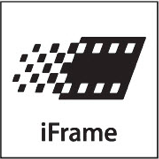Digital video is an electronic representation of moving visual images (video) in the form of encoded digital data. This is in contrast to analog video, which represents moving visual images with analog signals. Digital video comprises a series of digital images displayed in rapid succession.

Video is an electronic medium for the recording, copying, playback, broadcasting, and display of moving visual media. Video was first developed for mechanical television systems, which were quickly replaced by cathode ray tube (CRT) systems which were later replaced by flat panel displays of several types.

DV is a format for storing digital video. It was launched in 1995 with joint efforts of leading producers of video camera recorders.

S-VHS (スーパー・ヴィエイチエス), the common initialism for Super VHS, is an improved version of the VHS standard for consumer-level video recording. Victor Company of Japan introduced S-VHS in Japan in April 1987 with their JVC-branded HR-S7000 VCR, and in certain overseas markets soon afterward.

A camcorder is an electronic device originally combining a video camera and a videocassette recorder.

HDV is a format for recording of high-definition video on DV cassette tape. The format was originally developed by JVC and supported by Sony, Canon, and Sharp. The four companies formed the HDV consortium in September 2003.

D-VHS is a digital video recording format developed by JVC, in collaboration with Hitachi, Matsushita, and Philips. The "D" in D-VHS originally stood for "Data", but JVC renamed the format as "Digital VHS". Released in 1998, It uses the same physical cassette format and recording mechanism as S-VHS, and is capable of recording and displaying both standard-definition and high-definition content. The content data format is in MPEG transport stream, the same data format used for most digital television applications. The format was introduced in 1998.

XDCAM is a series of products for digital recording using random access solid-state memory media, introduced by Sony in 2003. Four different product lines – the XDCAM SD, XDCAM HD, XDCAM EX and XDCAM HD422 – differ in types of encoder used, frame size, container type and in recording media.
Digital audio cassette formats introduced to the professional audio and consumer markets:
AVCHD is a file-based format for the digital recording and playback of high-definition video.

D-9 or Digital-S as it was originally known, is a professional digital video videocassette format created by JVC in 1995. It is a direct competitor to Sony's Digital Betacam. Its name was changed to D-9 in 1999 by the SMPTE. It was used to a small extent in Europe and Asia and saw some use in the US, notably by the Fox News Channel, but was a commercial failure compared with Digital Betacam. It was superseded by high definition tapeless formats.
Sony produces professional, consumer, and prosumer camcorders.
M2TS is a filename extension used for the Blu-ray Disc Audio-Video (BDAV) MPEG-2 Transport Stream (M2TS) container file format. It is used for multiplexing audio, video and other streams. It is based on the MPEG-2 transport stream container. This container format is commonly used for high definition video on Blu-ray Disc and AVCHD.
MOD and TOD are recording formats for use in digital tapeless camcorders. The formats are comparable to XDCAM EX, HDV and AVCHD.

Digital movie cameras for digital cinematography are video cameras that capture coverage digitally rather than the historically used movie camera, which shoots on film stock. Different digital movie cameras output a variety of different acquisition formats. Cameras designed for domestic use have also been used for some low-budget independent productions.
The Apple Intermediate Codec is a high-quality 8-bit 4:2:0 video codec used mainly as a less processor-intensive way of working with long-GOP MPEG-2 footage such as HDV. It is recommended for use with all HD workflows in Final Cut Express, iMovie, and until Final Cut Pro version 5. The Apple Intermediate Codec abbreviated AIC is designed by Apple Inc. to be an intermediate format in an HDV and AVCHD workflow. It features high performance and quality, being less processor intensive to work with than other editing formats. Unlike native MPEG-2 based HDV - and similar to the standard-definition DV codec - the Apple Intermediate Codec does not use temporal compression, enabling every frame to be decoded immediately without decoding other frames. As a result of this, the Apple Intermediate Codec takes three to four times more space than HDV.

iFrame is a digital video format developed by Apple. It is based on existing industry standards, such as AVC/H.264, AAC and QuickTime, and can be used with compatible Mac and PC applications.

The XH-A1S is a digital video camera manufactured by Canon. The XH-A1S is an updated version of Canon’s XH-A1, and a newer version of the Canon GL2. It is generally used for independent filmmakers. It is one of the top Prosumer Camcorders in the market today.
XAVC is a recording format that was introduced by Sony on October 30, 2012. XAVC is a format that will be licensed to companies that want to make XAVC products.













